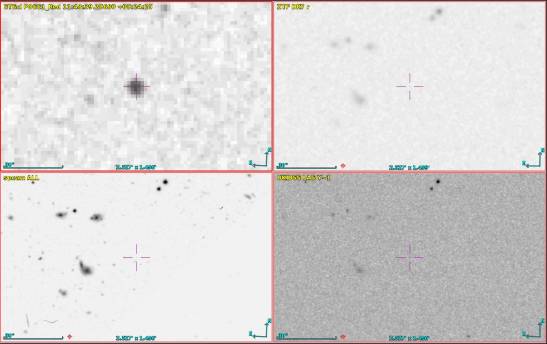Us 50’s century, a multitude of light sources were recorded in photographic plates overnight from the Palomar Observatory in California (USA), within an important astronomical study called the Palomar Observatory Sky Survey (POSS).
Now researchers at the Astrobiology Center (TAXIa mixed CSIC and INTA center) confirmed that objects detected on these plates do not show up in much more recent surveys such as the Gaia mission from space or Pan-STARRS from an observatory in Hawaii, using far more powerful telescopes and instruments.
O studyingaccepted for publication in the journal Monthly notices from the Royal Astronomical Societywas carried out with the Virtual Observatorya kind of Google astronomical tool that allows you to quickly and efficiently find and analyze everything related to any astronomical object.
With this tool, the authors analyzed thousands of images, with millions of objects, and looked for counterparts in dozens of astronomical files, each with millions of objects as well. Thus, they found that the ‘disappearances’ of stars and other objects can have different reasons.
Explanations for the ‘disappearances’
One possibility is that the objects identified on the photographic plates were never real, but mere flaws the same. The fact that the original plates are treated as true astronomical relics and their access is strictly limited, especially in these times of pandemic, makes this hypothesis very difficult to verify. However, it is highly unlikely that all the objects identified are plate defects and that they all have the expected spherical shape for stars. real.
Another possible explanation is that the object is still visible, but there are changed position. Regardless of being any asteroid (some were found among the analyzed sources), this category would fit those that are known by the name of stars with high self-motion.
To identify them, the authors used data from the Gaia mission, which generated the most complete census of star positions and velocities to date. And while there may be objects with high self-motion that haven’t been cataloged by Gaia, don’t expect to find many.
A third option is to claim that the object has not disappeared: it is still there, but the the brightness has diminished so much so that it is undetectable even with modern telescopes and instrumentation. In this case, the so-called variable stars, stars that change brightness.
specifically, the spectral type M stars with flares, they would explain a high percentage of those thousands of objects that have disappeared in recent decades. These would be objects that experienced a flash at the time they were observed in the 1950s and that, by the time more modern mapping took place, were in a much calmer state. and with brightness below the detection level.
Continuing with the explanations, another possibility is that the object has disappeared due to a unknown astrophysical process. According to certain models, very massive objects (more than 15 solar masses) can directly collapse into a black hole without going through the supernova phase.
These objects are known as failed supernovae. Some could have been visible in the 1950s and not be detectable on modern maps. However, although different failed supernova candidates have been proposed, we are still far from understanding their true nature (if they really exist).
discarded hypotheses
There are other options that have been discarded, such as the lost object being a artificial satellite (the first, Sputnik-1, was launched in October 1957 and 99% of the observations analyzed in the study were made between 1949 and 1956) or that the object was hidden by an alien civilization extremely technologically advanced.
Although this last hypothesis is very difficult to disprove 100%, experience (for example, the discovery of the first pulsar or anomalous changes in brightness in objects such as Tabby’s star or Betelgeuse) indicates that it is much more reasonable to associate the disappearance of these objects. to natural causes rather than developing alternative hypotheses.
By way of conclusion, the team states that there is no certainty of what they really are. They can be low-mass stars, other types of variable stars, uncataloged high-profile objects, previously unidentified asteroids, high-redshift supernovae, extragalactic objects, or even unknown astrophysical processes. The adventure of discovery is just beginning.
Per Henrique Solanoresearcher at the CAB who directed this work, “this list of objects is, without a doubt, a treasure to be explored in the short and medium term with new telescopes both terrestrial and space”.
“As an example – he adds – a preliminary analysis made it possible to identify a brown dwarf, a type of object that has already appeared in the observations of the 1950s and for which it was necessary to wait another 40 years for its official discovery”.
This study was carried out within the framework of the Vanishing & Appearing Sources project during a century of observations (BASQUE), led by astrophysicist Beatrice Villarroel from Stockholm University (Sweden) and whose objective is to search for rare and curious astronomical objects that may have disappeared or appeared in our sky.
